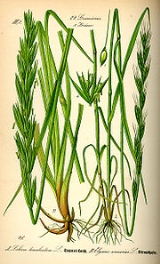
Lolium temulentum
Encyclopedia
Lolium temulentum, typically known as darnel, poison darnel or cockle, is an annual plant that forms part of the Poaceae
family and part of the Lolium genus. The plant stem can grow up to one meter tall, with inflorescence in the ears and purple grain. It has a global distribution
.
and is considered a weed
. The similarity between these two plants is so extensive that in some regions, cockle is referred to as "false wheat". It bears a close resemblance to wheat until the ear appears. The ears on the real wheat are so heavy it makes the entire plant droop downward, but L. temulentum, whose ears are light, stands up straight. The wheat will also appear brown when ripe, whereas the darnel is black. When the Lolium matures, the spikelets turn edgeways to the rachis, where the wheat spikelets remain as they grew previously.
The darnel can be infected by an endophytic
fungus
of the genus Neotyphodium
, and the endophyte-produced, insecticidal loline alkaloids
were first isolated from this plant.
It parasitizes wheat fields. The French word for darnel is ivraie (from Latin ebriacus, intoxicated), which expresses that weed's characteristic of making one feel poisoned with drunkenness, and can cause death. This characteristic is also alluded to in the scientific name (Latin temulentus = drunk).
:
Darnel is also mentioned as a weed in Shakespeare's King Lear. and is one of the many ingredients in Mithradate, which is supposed to have been used by Mithridates VI
on a daily basis to render him immune to poisoning.
Poaceae
The Poaceae is a large and nearly ubiquitous family of flowering plants. Members of this family are commonly called grasses, although the term "grass" is also applied to plants that are not in the Poaceae lineage, including the rushes and sedges...
family and part of the Lolium genus. The plant stem can grow up to one meter tall, with inflorescence in the ears and purple grain. It has a global distribution
Cosmopolitan distribution
In biogeography, a taxon is said to have a cosmopolitan distribution if its range extends across all or most of the world in appropriate habitats. For instance, the killer whale has a cosmopolitan distribution, extending over most of the world's oceans. Other examples include humans, the lichen...
.
Growth
Darnel usually grows in the same production zones as wheatWheat
Wheat is a cereal grain, originally from the Levant region of the Near East, but now cultivated worldwide. In 2007 world production of wheat was 607 million tons, making it the third most-produced cereal after maize and rice...
and is considered a weed
Weed
A weed in a general sense is a plant that is considered by the user of the term to be a nuisance, and normally applied to unwanted plants in human-controlled settings, especially farm fields and gardens, but also lawns, parks, woods, and other areas. More specifically, the term is often used to...
. The similarity between these two plants is so extensive that in some regions, cockle is referred to as "false wheat". It bears a close resemblance to wheat until the ear appears. The ears on the real wheat are so heavy it makes the entire plant droop downward, but L. temulentum, whose ears are light, stands up straight. The wheat will also appear brown when ripe, whereas the darnel is black. When the Lolium matures, the spikelets turn edgeways to the rachis, where the wheat spikelets remain as they grew previously.
The darnel can be infected by an endophytic
Endophyte
An endophyte is an endosymbiont, often a bacterium or fungus, that lives within a plant for at least part of its life without causing apparent disease. Endophytes are ubiquitous and have been found in all the species of plants studied to date; however, most of these endophyte/plant relationships...
fungus
Fungus
A fungus is a member of a large group of eukaryotic organisms that includes microorganisms such as yeasts and molds , as well as the more familiar mushrooms. These organisms are classified as a kingdom, Fungi, which is separate from plants, animals, and bacteria...
of the genus Neotyphodium
Neotyphodium
Neotyphodium is a form genus containing species of endophytic fungi. These endophytes are asexual, seed-borne symbionts of cool-season grasses, and grow intercellularly throughout the aerial tissues of their hosts, including shoot apical meristems, leaf sheaths and blades, inflorescences, seeds and...
, and the endophyte-produced, insecticidal loline alkaloids
Loline alkaloids
A loline alkaloid is a member of the 1-aminopyrrolizidines , which are bioactive natural products with several distinct biological and chemical features...
were first isolated from this plant.
It parasitizes wheat fields. The French word for darnel is ivraie (from Latin ebriacus, intoxicated), which expresses that weed's characteristic of making one feel poisoned with drunkenness, and can cause death. This characteristic is also alluded to in the scientific name (Latin temulentus = drunk).
Etymology
The plant is mentioned in Horace's Satire 2.6 (eaten by the Country mouse while he serves his guest fancier foods) and in the Parable of the Tares in the Gospel of MatthewGospel of Matthew
The Gospel According to Matthew is one of the four canonical gospels, one of the three synoptic gospels, and the first book of the New Testament. It tells of the life, ministry, death, and resurrection of Jesus of Nazareth...
:
Darnel is also mentioned as a weed in Shakespeare's King Lear. and is one of the many ingredients in Mithradate, which is supposed to have been used by Mithridates VI
Mithridates VI of Pontus
Mithridates VI or Mithradates VI Mithradates , from Old Persian Mithradatha, "gift of Mithra"; 134 BC – 63 BC, also known as Mithradates the Great and Eupator Dionysius, was king of Pontus and Armenia Minor in northern Anatolia from about 120 BC to 63 BC...
on a daily basis to render him immune to poisoning.

